By Tom McHale
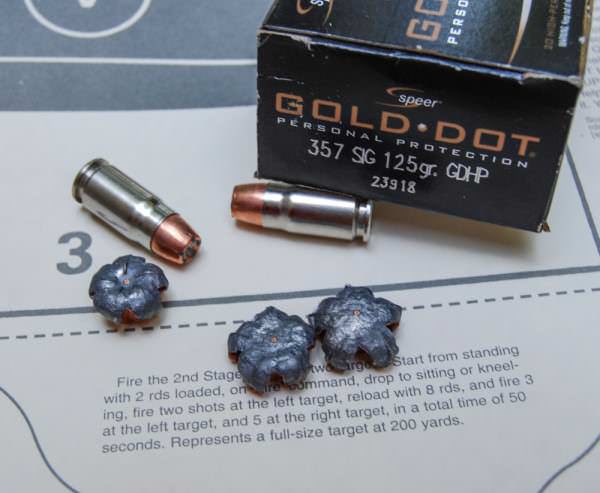

USA –-(Ammoland.com)- I dig the .357 Sig.
In fact, I dig it so much, I feel like I’m on a one-man campaign to help boost it into the shooting mainstream.
One of the biggest gripes people have about the .357 Sig cartridge is the cost, but that becomes a non-issue as more people start to use it. Volume begets cheapness – the more they make, the lower the cost.
Whatever your position in the caliber wars, you have to admit that 9mm is making a resurgence as a great defensive caliber, and hey, .357 is a 9mm on steroids, right?
What is the .357 Sig?
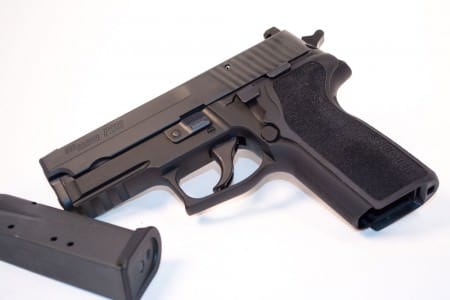
Some folks refer to this cartridge as a necked-down .40 Smith & Wesson. Conceptually, that’s kinda true, but there are technical differences. The cartridge base is the same dimension and the main part of the case body is the same diameter, but the .357 Sig case is not made from a .40 S&W case. The projectile is the same as a 9mm at .355 inches diameter.
Because of these similarities to the .40 S&W, you can often just swap barrels to change your pistol from .40 S&W to .357 Sig or vice versa. Magazines are generally compatible between the two calibers as well. Always check with your particular handgun manufacturer first before embarking on caliber changes.
If you want to understand the benefit of .357 Sig, just think this. It’s got the magazine capacity of a .40 S&W in any given gun, and it has a 200 to 400 foot per second velocity advantage over 9mm, depending on the load. While .357 Sig can’t match the specs of those uber-macho 158 grain .357 Magnum loads, it does compare favorably with 125 grain .357 Magnum.
One other thing to note. The .357 Sig is a bottleneck-shaped cartridge. This provides another hidden advantage – feeding is exceptionally reliable.
With any of the four .357 Sig pistols I currently have (Sig P226, Sig P229, Glock 32 and Glock 31), I can limp wrist like Pee Wee Herman and the guns will still cycle properly.
Ballistic Science
Earlier I mentioned that .357 Sig approaches .357 Magnum territory, but from a semi-automatic pistol. It’s close. Real close. To see how close, I went out to the range and clocked a slew of them using a Shooting Crony Beta Master chronograph placed 15 feet down range. Here’s what I found.
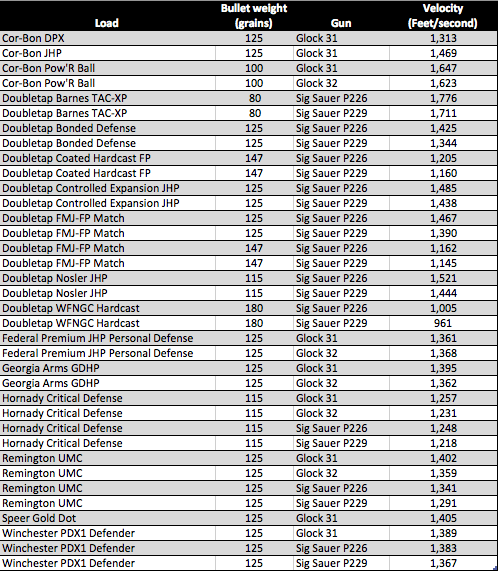
Of all the loads I tested, average velocity was 1,363 feet per second, and that includes those fat and (relatively) slow 180 grain hard cast cruisers from Doubletap Ammunition.
Recoil
Felt recoil is a subjective thing. What I consider “snappy” might be considered tame by someone else, say Chuck Norris. Fortunately, like muzzle energy and momentum, recoil energy can be calculated as well. The easiest way to compare recoil of one load versus another is to head over to my buddy Andrew Chamberlain’s Cartridge Comparison Guide ( tiny.cc/gg7zdx ) . He’s a math whiz and does engineering stuff. Whatever it is that he does, he shoots a lot, breaks out his slide rule and writes it all down in the book.
According to the Cartridge Comparison Guide, an “average” .357 Sig load compares to other “average” loads as follows:
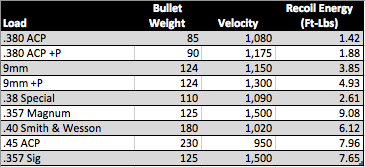
Geeky Info with No Practical Application
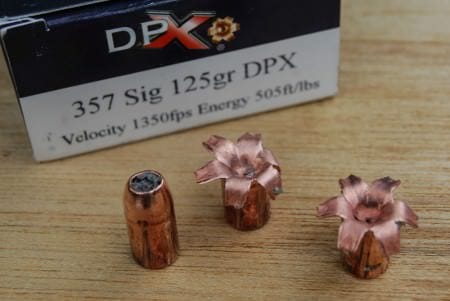
You’ll hear people describe the .357 Sig as a “flat shooting” cartridge. It certainly is, but I’m not sure what difference that makes at normal handgun ranges. Nonetheless, I get a kick out of plinking at stuff with a Sig Sauer P226 at 100-yard distant targets. Why not?
If you do some cocktail napkin math, you’ll find that a 9mm, 124 grain bullet, fired at 1,150 feet per second, will drop about 10 inches over 100 yards. That’s assuming the sight is ½ inch above the bore, and your zero is at 25 yards. A 125 grain .357 Sig bullet, moving at 1,400 feet per second, will drop only about 6.8 inches under the same conditions.
There are eleventy-million variables, but that’s the rough math. So yes, it’s a flatter shooting round. Is that relevant? That’s up to you.
An Epistle on Expansion

A little velocity goes a long way when it comes to reliable expansion. An extra 100, or even 50, feet per second in velocity can make all the difference as to whether a projectile expands or not. Just to be clear on that statement, I’m talking about expansion performance in more real world scenarios.
Any modern hollow point bullet will expand if you shoot it into water or pure ballistic gelatin – that’s an ideal situation to get perfectly expanded bullets suitable for the cover of Ballistics Freak magazine.
Consistent bullet expansion performance starts to get iffy when you introduce barriers in front of the water or ballistic gelatin – things like clothing, coats or even hard barriers like glass or car doors. Softer barriers like clothing can clog up hollow points, and harder barriers tend to press the cavity inwards instead of outwards.
In my ammo expansion testing over the years, I’ve noticed one universal truth: velocity rules once you start introducing barriers. Ammo engineers can make bullets that expand at virtually any velocity. They don’t create bullets that expand too easily, however, as penetration is the other fundamental goal. Too much of one comes at the expense of the other. Under controlled conditions, they can make a bullet that expands every time within a certain velocity range. Where things get dicey is with barriers. That makes performance unpredictable. However, driving that bullet a bit faster tends to make it work more consistently and overcome the barrier uncertainty.
Purely in the name of science, I decided to do something a bit on the silly side. It’s not a realistic test, unless bad guys and other nefarious home invaders use body armor made of kitchen cutting boards, but it does illustrate the benefit of velocity.
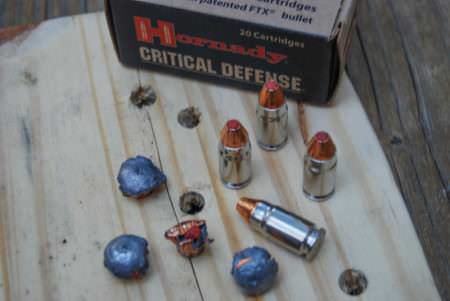
To illustrate my “velocity rules” theory, I decided to try a ridiculously tough (and unrealistic) barrier in front of the ballistic gelatin – a plastic kitchen cutting board. It’s about ¾ inches thick, tough, and resilient enough to clog up hollow points. As you can see in the photo, the only cartridge among those I tested that managed to expand after passing through this expansion limiting nightmare, was the .357 Sig. Just for kicks, I also did similar “tests” shooting through things like stone floor tiles, bags of flour, pine boards and the Sunday Edition of the New York Times (I wanted to see if .357 Sig could penetrate a big pile of BS. It did.) Without fail, the .357 Sig performance exceed all others in comparison.
What does that tell us? Not much, except that it’s fun to shoot through silly things to see what happens. But seriously, I think it does provide at least some indication that extra velocity helps overcome some of the challenges that projectiles face. I’ve seen similar indications from shooting identical bullets from long and short barrel guns. The bullets from longer barreled handguns have more velocity and tend to perform better. Physics or something.
Feelings
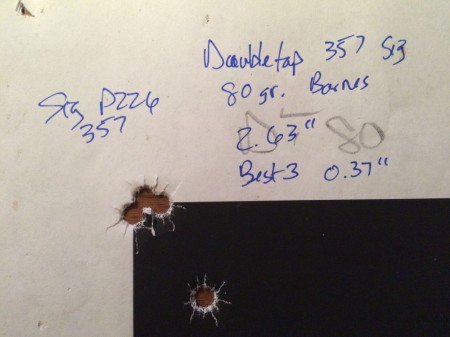
Here’s the thing. For all the talk about velocity, we’re still talking about a standard weight 9mm bullet, so recoil is manageable. Yes, “felt recoil” is a totally subjective thing, but to me, the .357 Sig shoots softer than an equivalent gun chambered in .40 S&W.
The math says otherwise, but hey, I’m entitled to my feelings, right?
Is it right for you? Maybe. Is it NOT right for you? Maybe. A number of law enforcement agencies at local, state and federal level use it, and they have to meet the requirements of a broad cross section of shooters, so that says something. Given that it operates at the higher level of the handgun recoil scale, it takes practice commitment. After all, the only thing that counts is getting hits on target. If you can do that, then all the other things like velocity and expansion results don’t matter.
I’m sticking with it. I got hooked on the .357 Sig cartridge with a Glock 32 and later a Glock 31. Recently, I upgraded to a Sig P226 and Sig 229. Already I’ve determined I’m never giving those up. The superior grip ergonomics of the Sig, combined with eight ounces of extra weight and real metal construction make it a sweet shooter in .357 Sig caliber. More on those Sigs soon.
About
Tom McHale is the author of the Insanely Practical Guides book series that guides new and experienced shooters alike in a fun, approachable, and practical way. His books are available in print and eBook format on Amazon. You can also find him on Google+, Facebook, Twitter and Pinterest.

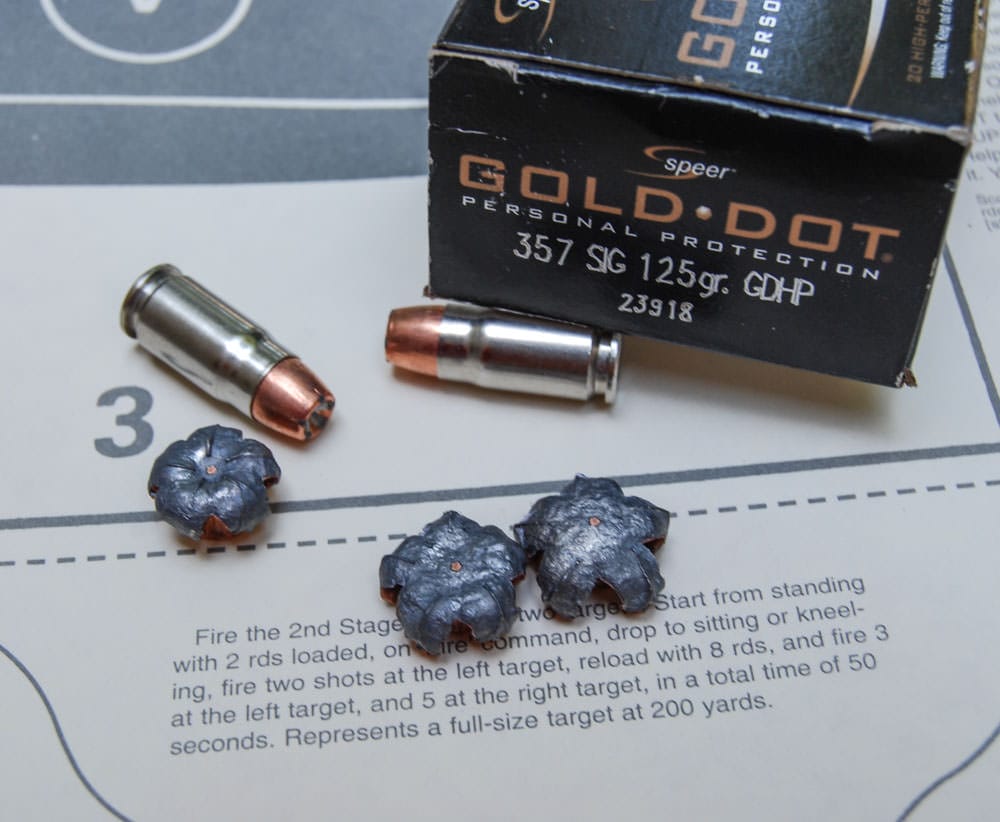

I did a twenty two year career with the Highway Patrol in Central Montana. The area I worked was full of deer, elk, bear, moose as well as various and sundry farm animals; horses, pigs, sheep and cows. I investigated hundreds and hundreds of motor vehicle versus animal accidents. Many times, especially with deer or elk the animal was not dead and had to be shot. I have shot all of the animals listed many times and over the years using several different handgun cartridges…the .357 SIG was THE hands down, quickest killer. I am not comparing performance on game… Read more »
I love my sig 229r in 357 sig.as far as the cost of ammo I go to freedomunitions.com and get 50 rounds for around $20.00 or less.i even buy my factory magtech 10mm there for $14.99/box of 50. Great prices.and as far as the 357 sig I carry it 24/7.i love it so much I bought a wolf conversion barrel for my glock 27 and have never went back to my 40 s&w barrel at all.
I shoot all calibers. In the P229 and P226, I shoot 40, 357s, and have a Barsto 9mm barrels for each as well. When I’m done practicing with 9mm and 40, I load 357s as ready pistols. I practice with 357s as often as I can, much like defensive ammo in general. The word “reliable” is the operative word as it relates to expansion: a function of velocity and design. It should expand always for my purposes, so long as penetration is in acceptable range. The cost is a killer, but I view them as defensive rounds, so they get… Read more »
Can .357SIG Ammo be used with a standard .357 6 shot revolver? I’m confused on what it can be used for and what I can’t. Thanks for your help.
The .357 sig and .357 magnum are 2 totally different rounds and are not interchangeable.
I have been shooting auto hand guns for over 35 years, many 45 acp 1911’s, glock 21 SF & HK, many 9mm’s, sig 226, 229, M11-A1, several beretta 92, several browning HP’s, glocks, SW, etc., glock 20, 10mm, they have there merits good and bad, but probably the last pistol I will ever own is a Glock 31 gen 4, And I only shot it 2 times ! 2 rounds thru the bulls eye holes touching, didn’t want to pull the 3rd round off, ha ha, high capacity, high velocity, accuracy, reliability, slim package easy carry, safe concealed carry, cross… Read more »
I really do like the 357 Sig ballistics and gel test performance. I have many 1911’s in 45 ACP, and Glocks in 9mm, 357/40, 10mm and 45 ACP. I recently purchased a Sig 1911 Nightmare in 357 Sig, and it is very reliable. It is a fun gun to shoot, and Underwood rocks in the 357 Sig 125gr @ 1475 fps.. For defensive rounds you can’t go wrong with Underwood. Underwood, DT and Buffalo Bore all help 357 Sig approach the 357 Magnum ballistics. On the lighter side another great choice for 357 Sig which is loaded closer to a… Read more »
I dig the 357 Sig also! My P229 has 116 different loads thru it…and I have a few more to try! 21 years old and going strong!!
For even more performance from the 357 SIG try out the Underwood line of ammo. They list the 125gr load at 1475fps and it usually delivers more. For greater performance from all 357 SIG ammo, take a look at the Springfield Armory XD357 Tactical. It has a 5″ barrel to get the last bit of performance. It shoots very accurately, and is well made. Definitely worth a look…
Guess I am too old fashioned but my favorite cartridge is a .45 ACP. Shot from, in my case, an STI Elektra. Yes, I hear about all of the ergonomics the new guns have but none I have tried are better than my 1911. Give one a try they have progressed a lot since the original 1911. Wonder if the plastic guns will be around as long?
I’m one of the people the author was talking about who won’t buy a gun in .357 Sig because of the price and availability of the ammo. So, all of you should start buying them to bring down the price. Then, I’ll spring for a new barrel for my Smith and Wesson M&P 40. Seriously though, I think the .357 Sig is going to suffer the same fate as the old 10mm. That was a pretty hot round too but, not many people are going to pay double for a box of ammo.
If you can find any of the 100gr frangible that Black Hills was making its an ideal training round. The Rem Golden Sabers are extreme efficient.
I have been using my Glock 31 that is a Secret Service gun that Glock cleaned up and sold after they traded them in for new ones, glock said they do this every fw years and they usually have another gov Agency that buys them after they have been refurbished but a few get out time to time, I’ll admit having a Secret Service serial # is pretty cool, but I also have a 32 and it is a Gun that was specially made for the Oklahoma highway patrol where i live, a few officers didn’t buy the one’s they… Read more »
Hey, you never know, cutting boards could be the new body armor of choice for thugs everywhere!
I’ll settle for the 9mm Speer Gold Dot +P+ LE (law enforcement restricted). $25 for a box of 50 at SG Ammo.
The .357 Sig is just one of them rounds that never interested me. (all my handguns are 45ACP with the exception of a .357 mag and 38 Sp. rev’s) The 300 blackout is another round that just doesn’t really strike any interest with me. (great rd suppressed for tact.situations I hear). I know they are fine calibers and alot of people swear by them. I just dont really like change I guess.
Thanks for your review on the .357 Sig. I have been shooting this round in my Sig P229 (along with .40 S&W) for many years. I don’t feel the impact of the ammo cost as much as some folks as I reload for both. Unfortunately I feel that the .357 Sig will wane in popularity over time, as most of the law enforcement folks have converted to .40 S&W or 9mm, thus the driver for lower cost ammo just isn’t there anymore. Kinda sad considering what an awesome round it is. I wish more folks would give it a whirl,… Read more »